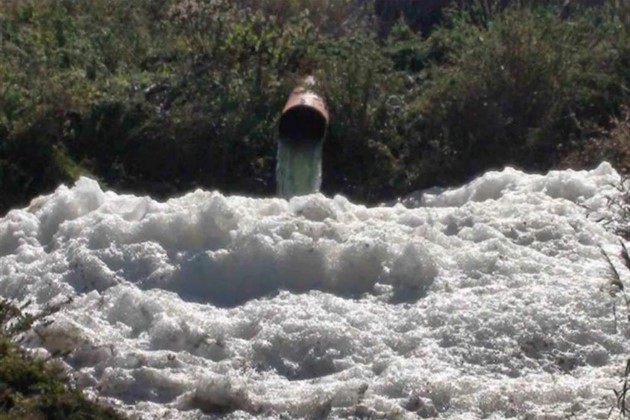Acque Potabili In Italia: Allarme PFAS - Cosa Dobbiamo Sapere

Acque Potabili In Italia: Allarme PFAS - Cosa Dobbiamo Sapere. Discover more detailed and exciting information on our website. Click the link below to start your adventure: Visit Best Website. Don't miss out!
Table of Contents
Acque Potabili in Italia: Allarme PFAS - Cosa Dobbiamo Sapere
Italy faces a growing concern regarding the contamination of its drinking water with PFAS, per- and polyfluoroalkyl substances. This alarming situation demands immediate attention and understanding from citizens across the nation. This article delves into the current PFAS crisis in Italy, exploring its sources, health impacts, and what steps individuals can take to protect themselves and their families.
What are PFAS and Why are They Dangerous?
PFAS are a group of man-made chemicals used in various products, from non-stick cookware to firefighting foam. Their persistence in the environment and resistance to degradation earn them the moniker "forever chemicals." The problem is exacerbated by their ability to accumulate in the human body, potentially leading to severe health consequences. Exposure to high levels of PFAS is linked to:
- Increased risk of certain cancers: including kidney and testicular cancer.
- Impaired immune function: making individuals more susceptible to infections.
- Liver damage: potentially leading to serious liver disease.
- Thyroid disorders: impacting hormone regulation.
- Developmental problems in children: affecting growth and cognitive development.
The PFAS Contamination Crisis in Italy: A Regional Breakdown
While the contamination isn't uniform across the country, several regions in Italy are facing particularly high levels of PFAS in their drinking water. Veneto and Lombardia are currently grappling with some of the most significant outbreaks. However, other areas are also showing concerning levels, highlighting the widespread nature of this environmental threat. Precise locations and levels of contamination are continuously updated by regional health authorities; it's crucial to check local news and official government websites for the latest information relevant to your specific area.
Sources of PFAS Contamination in Italian Water Supplies
The primary sources of PFAS contamination in Italy often trace back to:
- Industrial discharges: Manufacturing plants and industrial sites that historically used PFAS-containing products.
- Military sites: Firefighting training exercises using aqueous film-forming foam (AFFF), a major source of PFAS, have left lasting contamination.
- Agricultural runoff: PFAS can leach into soil and groundwater from contaminated sites, eventually contaminating water sources.
What Can You Do to Protect Yourself?
Staying informed is the first step. Regularly check your local water authority's website for updates on water quality and PFAS levels in your area. Consider these further actions:
- Install a water filter: High-quality water filters, specifically designed to remove PFAS, can significantly reduce your exposure. Research reputable brands and ensure the filter is certified for PFAS removal.
- Use bottled water: For drinking and cooking, opt for bottled water certified as PFAS-free. However, this is a costly long-term solution.
- Support advocacy groups: Many organizations are working to raise awareness and advocate for stricter regulations and cleanup efforts. Your support can make a significant difference.
- Contact your local authorities: Report any suspected PFAS contamination and demand action from your elected officials.
The Future of PFAS Remediation in Italy
The Italian government is facing increasing pressure to address the PFAS crisis effectively. Large-scale remediation projects are necessary, requiring significant investment and long-term commitment. This involves not only cleaning up contaminated sites but also implementing stricter regulations to prevent future contamination. The ongoing monitoring of water quality and public health is paramount to ensuring the safety of Italian citizens.
Stay informed, take proactive steps, and demand accountability from those responsible for this environmental catastrophe. The health and well-being of the Italian population depends on it.

Thank you for visiting our website wich cover about Acque Potabili In Italia: Allarme PFAS - Cosa Dobbiamo Sapere. We hope the information provided has been useful to you. Feel free to contact us if you have any questions or need further assistance. See you next time and dont miss to bookmark.
Featured Posts
-
 Open Junior Girls Semifinals Aussie Jones Path To Victory
Jan 24, 2025
Open Junior Girls Semifinals Aussie Jones Path To Victory
Jan 24, 2025 -
 Anestesia Fatal Muere El Influencer Ricardo Godoi En Brasil
Jan 24, 2025
Anestesia Fatal Muere El Influencer Ricardo Godoi En Brasil
Jan 24, 2025 -
 Starlink V2 Deployment Space X Aims For Broader Faster Internet Coverage
Jan 24, 2025
Starlink V2 Deployment Space X Aims For Broader Faster Internet Coverage
Jan 24, 2025 -
 Ticketmaster Pierde En La Corte Consecuencias Para Los Usuarios
Jan 24, 2025
Ticketmaster Pierde En La Corte Consecuencias Para Los Usuarios
Jan 24, 2025 -
 Bof As Reassuring Message Why High Stock Market Valuations Arent A Threat
Jan 24, 2025
Bof As Reassuring Message Why High Stock Market Valuations Arent A Threat
Jan 24, 2025
